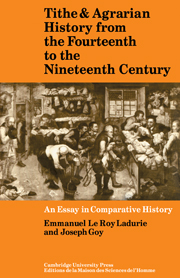 Tithe and Agrarian History from the Fourteenth to the Nineteenth Century
Tithe and Agrarian History from the Fourteenth to the Nineteenth Century Preface
Published online by Cambridge University Press: 05 November 2011
Summary
The present volume aims at describing, for the Englishspeaking public, the present state of research on the tithe. This kind of payment, typical of the agrarian ancien régime, is of great value for historians because it serves as a rough indicator of changes in the agricultural product (grain, wine etc.) from year to year, decade to decade, or over longer periods. This assertion is true in essence for traditional societies, such as France before 1789, and other countries of Europe and Latin America in the nineteenth century.
The tithe, however, is inseparable from a whole series of other revenues which came from the land and filled, in theory at least, the coffers and the barns of the great landowners, whether they were members of the clergy, the nobility or the upper bourgeoisie. Consequently, we have not separated the tithes (our main preoccupation) from the other revenues derived from the land (rents, seigneurial dues etc.).
This book is divided into two parts. The first part, by Joseph Goy, deals with methodology. The second part is by Emmanuel Le Roy Ladurie with the collaboration of Marie-Jeanne Tits-Dieuaide; this portion deals with long term fluctuations in the product of the tithe and other revenues from the fourteenth to the nineteenth centuries. It is a work of comparative history, focussed on Europe but touching on America, and draws upon the research of nearly a hundred historians from many countries, to whom we are most grateful.
- Type
- Chapter
- Information
- Tithe and Agrarian History from the Fourteenth to the Nineteenth CenturyAn Essay in Comparative History, pp. ix - xPublisher: Cambridge University PressPrint publication year: 1982
